Drinking whiskey from a glass tumbler — perhaps while sitting in a leather chair, reading a leather-bound book — has been a classic male pastime for hundreds of years.
In the modern age, companies have introduced what they claim are advancements in this age-old activity: glasses that supposedly enhance the drinking experience.
As a semi-regular whiskey drinker, these innovations in glassware have intrigued me. I wondered if they would noticeably change the flavor/experience, not only for a whiskey connoisseur, but for a more Average Joe drinker like myself. Sure, I can differentiate between high end and low end whiskies, but I’m never going to analyze flavor profiles or drop huge coin on a bottle. My usual commentary is more along the lines of “Oh man, that’s smooth and tasty†rather than “I detect faint notes of persimmon at the start and a real punch of toasted American oak in the finish.†Would a special glass make a real difference for a guy who can enjoy even the cheaper brands?
To find out, I tested 4 specialty whiskey glasses against my own classic rocks glass. Below I break them down. Did any of them really work? Could I notice a difference in flavor? Was all that “engineering†worth the associated price tag for the average guy? And ultimately, what ended up being my favorite drinking vessel?
Aged & Ore Duo Glass

All photos of glasses are taken with 2oz of whiskey contained within.
Cost: $48 for a pair (includes ice ball molds)
Features & Verdict:
Double-walled insulation. Claims to keep your drink cool “for literally hours on end.†That’s fine, and appreciated, but why on earth do I need my drink to stay cool for that long? My own dram will be gone long before this feature takes effect!
Integrated measuring lines. This was a unique feature that I didn’t see on any other tested vessel. There are eight indented lines in the glass which each represent 1 oz of liquid. Indeed handy, but really only if you’re drinking your whiskey neat. If you prefer ice, the lines don’t do much good, since you aren’t going to pour the drink and then add ice.
Bell shape. The claim is that it’s designed for “better aromatics and ethanol aeration.†It’s supposed to make your drink taste smoother, but I didn’t notice any difference when compared to a normal glass. That bell shape does perfectly hold an ice ball, which they provide molds for when you buy this set. Kinda neat I guess, but doesn’t have much real benefit.
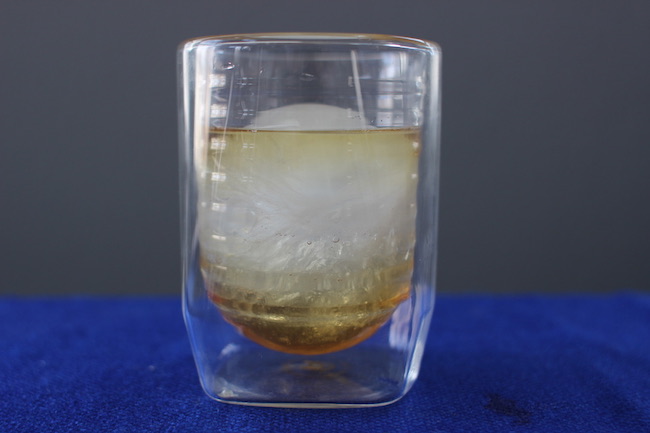
With ice.
Made with lightweight borosilicate glass. I did some homework here, and that borosilicate is indeed a nice feature. It’s just a special type of glass that’s “thermal shock resistant.†In layman’s terms: it won’t crack/break with extreme temperature changes. It’s the type of glass that nice restaurants and laboratories use. What I don’t like is the “lightweight†part. Feels like a feather when you’re holding it. Anecdotally, most whiskey drinkers I know much prefer a hefty glass. Something you can actually feel in your hand. With this one, I felt like I’d just drop it because I forgot it was there.
Overall: The measuring lines are nice, and it certainly looks unique, but there’s no noticeable difference in flavor and it’s too lightweight for folks who like some heft in their vessel.
Norlan Whiskey Glass
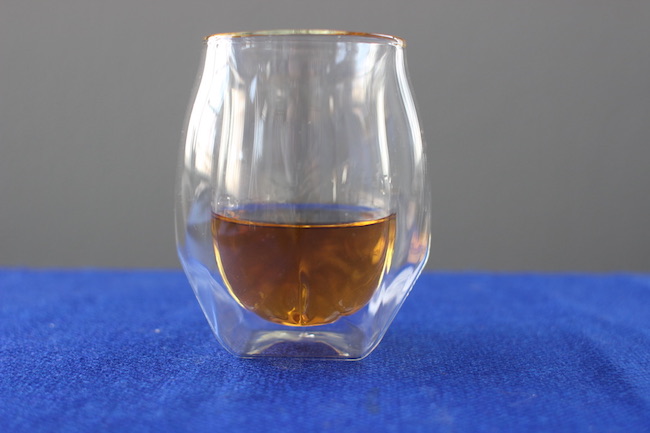
Cost: $48 for a pair
Features/Verdict:
Double-walled insulation. See my notes above about the Aged & Ore glass.
Indentations for better aeration. There are a few wave-like indentations at the bottom of the glass that are supposed to improve aeration and therefore reduce the ethanol burn that comes with drinking whiskey. I perhaps noticed a small difference when comparing to a normal glass, but not as much as with the NEAT glass (see below).
Made with lightweight borosilicate glass. See my notes above about the Aged & Ore glass.
Concave outer rim. With the double wall, the lip of the glass ends up sort of thick. It can make for drinking that’s a little less than optimal. The Norlan combats that by curving the lip out just a little bit so that it better conforms to your mouth as you drink. It’s somewhat noticeable, but honestly doesn’t make that much of a difference.
Overall: This is very similar to the Aged & Ore glass, and is even the exact same price. This glass doesn’t have the measurement markings, but it does have the aerating indents. I basically had the same feelings about this glass as the other one. It looks unique, but there’s not much difference in actual flavor, and it’s still a bit lightweight for my preferences.
The NEAT Whiskey Glass
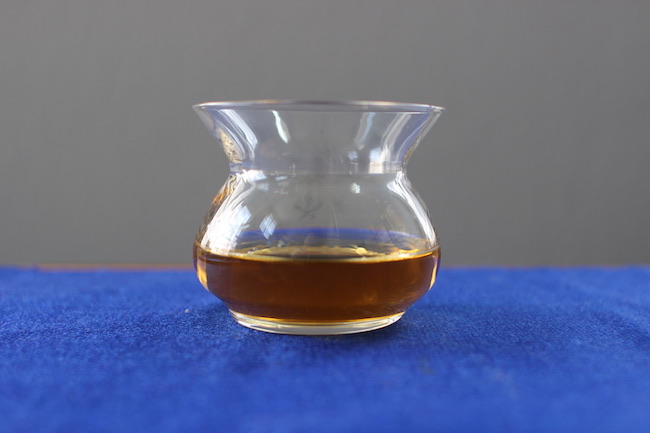
Cost: $25 for a pair
Features/Verdict:
Especially unique shape. This is the primary selling point of this glass. The extra wide bottom, the tapered middle, and the extra wide mouth are supposedly highly engineered based on the science of how alcohol vapors hit the nose.
Wine and beer glasses are almost always tapered toward the top, to better concentrate the aromas, which add a lot to the taste and overall enjoyment of those drinks. With distilled beverages though, those aromas can get too strong, to the point where you’re only getting the potent alcohol vapors rather than the scent of the whiskey itself. This is less of an issue with high-quality whiskies, as they’re purer products.
NEAT claims to give the drinker the best of both worlds, in that its wide bottom provides better aeration and concentrates aromas in the center, while the wide mouth — very unusual in tasting glasses — diffuses the harsh alcohol vapors that you often get when smelling (“nosingâ€) your whiskey. That combination of aeration and diffusion does actually work to create a smoother drinking experience. Huzzah! I was actually pretty surprised that there was a noticeable difference between the same whiskey served in this glass versus the standard rocks glass that I usually prefer.
This shape, however, was also somewhat of a detractor for me. Imagine serving a couple ounces of whiskey to your friends with this glass; it just comes off a bit douchey doesn’t it? Or if you’re by yourself on a weekend evening and taking in a nice big biography, is this the glass you’re going to reach for? (I tried it, and it felt weird.) Unless you’re having a tasting party or something, I can’t imagine these coming out much.
Comparatively thin glass. This is a feature that adds to the visual aspects of assessing a whiskey. With a double-walled glass or a heavy, thick-walled crystal, the view is muddled, so you can’t get a good look at the beverage’s true color and clarity. These visual features aren’t necessarily important for casual drinkers, but they are indeed nice for amateur connoisseurs who enjoy getting a clean look at what they’re drinking. On the flip side, this does make it lightweight, which as I’ve mentioned, I don’t particularly enjoy.
Overall: The NEAT indeed stands up to its claims, which is nice, and at a price point that’s half of what a couple of these other sets are. However, the fancy shape combined with its lightweight feel make for a glass that I just don’t realistically see using all that much unless I have a very nice whiskey that I want to drink neat. The NEAT also has a low capacity of just 2-3 oz; it’s truly only designed to drink whiskey sans ice, and I for one almost always prefer ice — even with nice whiskies.
Glencairn Whiskey Glass
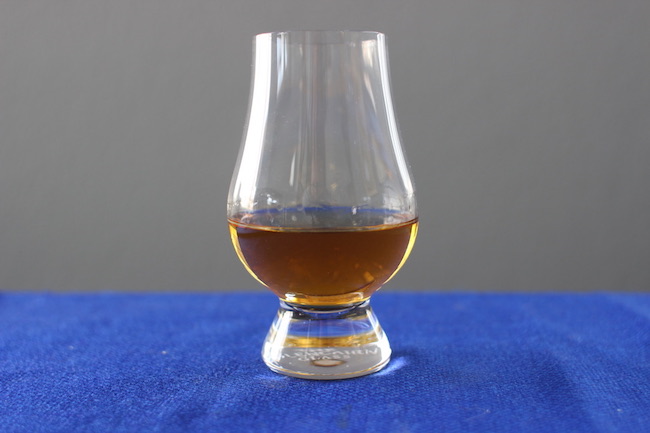
Cost: $17 for a pair
Features/Verdict:
This glass deserves some backstory, since it’s probably the most well-known on this list. First introduced in 2001, it’s been the standard go-to for whiskey tasting for the last couple decades. Designed in Scotland, it’s modeled after the tasting glasses that Scotch labs across the region use. The reason this particular glass became semi-famous in the whiskey world is that it was the first to be endorsed by the Scotch Whisky Association and is now in use all over the world.
On to the features:
Semi-wide bowl. The rounded, semi-wide bowl is designed for better aeration, which is supposed to make it smoother on the taste buds. I didn’t notice a difference, though.
Comparatively thin glass. See note above on the NEAT.
Narrow, tapered mouth. As mentioned above, the problem of getting an excess dose of harsh alcohol vapors is minimized when you’re drinking a premium whiskey; you want to get a nice nose-full when you’re drinking the good stuff. It’s with that fact in mind (if you’re going to be using this glass, you’re probably going to be using it for nice whiskey) that the Glencairn glass tapers to a more narrow mouth, to really maximize the nosing experience. However, the small mouth of this glass concentrates the fumes a little too much, in my opinion. And it also makes for sort of awkward drinking; you have to almost pucker your lips to take any sips.
Overall: I have about the same feelings towards the Glencairn as the NEAT, except this one didn’t even enhance the flavor at all. It’s small, too lightweight, and honestly just feels kind of dainty. And I’m not alone in my poor opinion of the famed glass.
Classic, Hefty “Rocks†Glass
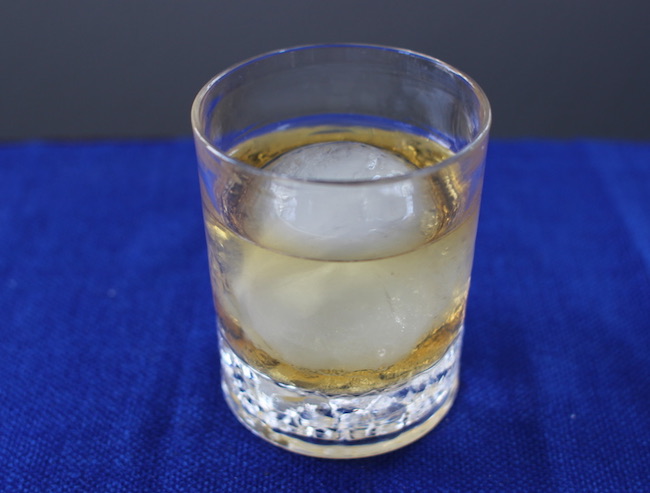
Cost: Varies, but nice sets can be had for $8-$10 per glass (I have no particular brand in mind here, though Waterford makes high-quality affordable sets)
Features/Verdict:
Even after all the testing I did, my favorite glass to use remains a heavy glass with a thick bottom, nice thick walls, and a wide mouth. The ones I use don’t have any special features in particular other than their heft. I like a glass I can get my whole hand around — not some dainty, lightweight thing that feels like my paws will crush if I squeeze too hard.
I also like a versatile vessel — outside of the Aged & Ore glass, none of those tested are suitable for cocktails, or really even drinking your whiskey with ice. The ones above will surely work well for professional tasters and armchair connoisseurs, as well as busting out for a tasting party with friends. But none work well as everyday use glasses except for the guy who exclusively drinks premium whiskies served neat.
While specially designed whiskey glasses look sort of fun, in reality they just aren’t terribly practical or, dare I say, manly. The NEAT can improve the flavor if drinking a high-end whiskey, but really, a quality product is going to taste good in any glass. What matters most is your own preferences, and I for one am sticking with my classic rocks glass.
Tags: Vices


